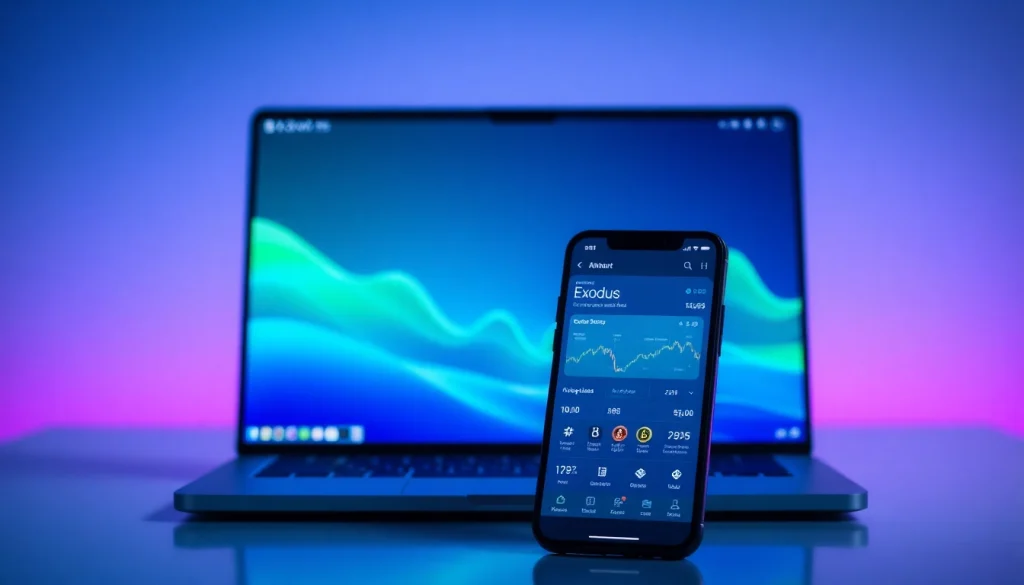
Introduction to Exodus Wallet: What You Need to Know
The rise of digital currencies has led to the emergence of various cryptocurrency wallets, each offering distinct features and functionalities. One of the notable options available to users today is the exodus wallet, which combines an intuitive design with robust security measures. As the cryptocurrency market continues to grow, understanding the essentials of an effective digital wallet has become more crucial than ever. In this article, we will delve deep into the Exodus wallet, exploring its features, setup procedures, and how it stacks up against its competitors.
Understanding Cryptocurrency Wallets
At its core, a cryptocurrency wallet is a software application or hardware device that enables users to manage their digital assets. Different types of wallets are available, including hot wallets (online) and cold wallets (offline). Hot wallets, like the Exodus wallet, offer quick access to your assets and are ideal for frequent trading, while cold wallets provide enhanced security for long-term storage of cryptocurrencies.
Cryptocurrency wallets store public and private keys—the latter being crucial for accessing and managing your funds. While public keys are like your bank account number that can be shared with others, private keys should remain confidential to protect your assets. Understanding the differences between types of wallets can help users choose one that aligns with their crypto management strategies.
The Importance of Security in Digital Wallets
As the number of cyber threats grows, security remains a paramount concern for cryptocurrency users. The Exodus wallet takes several measures to safeguard user assets, such as:
- Backups: Users can back up their wallet to ensure recovery in case of device loss.
- Encryption: Private keys are encrypted on the device, minimizing the risk of unauthorized access.
- Multi-signature support: This feature enables multiple parties to authorize transactions, enhancing security for shared accounts.
Despite these measures, users must remain vigilant, employing best practices like using strong passwords and maintaining two-factor authentication to bolster their wallet’s security further.
Overview of the Exodus Wallet Features
The Exodus wallet stands out not only for its user-friendly interface but also for its diverse features that cater to both novice and experienced users. Some key features include:
- Multi-currency support: Exodus allows users to manage numerous cryptocurrencies, making it a versatile choice for traders and investors.
- Integrated exchange: Users can swap cryptocurrencies directly within the wallet without needing to rely on external exchanges.
- Portfolio tracking: The built-in portfolio tracker provides real-time insights into the user’s holdings, making it easy to monitor investments.
Setting Up Your Exodus Wallet: A Step-by-Step Guide
Creating Your Wallet Account
Setting up your Exodus wallet is straightforward, even for those who are not technically inclined. To get started, follow these simple steps:
- Download the Exodus wallet from the official website or the appropriate app store for your device.
- Install the application and open it. You will be prompted to create a new wallet.
- Generate a secure password. Make sure it is strong and unique.
- Back up your recovery phrase, which is crucial for recovering your wallet if you lose access. Write it down and store it in a safe place.
Setting Up Security Features
After creating your wallet account, it is essential to configure the security features available within the Exodus wallet:
- Enable password protection: This provides an extra layer of security during wallet access.
- Two-factor authentication: While Exodus doesn’t directly offer 2FA, you can use two-factor applications for additional security if you connect it to exchanges.
- Regular software updates: Keeping your wallet updated ensures you always have the latest security enhancements.
Linking to Your Bank or Crypto Exchanges
The Exodus wallet allows users to purchase cryptocurrencies directly or link accounts from various exchanges, making management more accessible:
- Log into your Exodus wallet and navigate to the swap feature.
- Select the currency you wish to purchase and the payment method (such as bank transfer or debit card).
- Follow the prompts to complete your purchase securely.
Since Exodus partners with various third-party providers for these services, ensure you read their fees and terms before finalizing transactions.
Exploring the Features of the Exodus Wallet
Built-in Exchange for Seamless Cryptocurrency Swaps
One of the standout features of the Exodus wallet is its integrated exchange. This allows users to swiftly swap between different cryptocurrencies without exiting the wallet environment. The process is typically as follows:
- Select the two cryptocurrencies you wish to swap.
- Enter the amount and review the transaction details, including fees.
- Confirm the swap, and the changes will instantly reflect in your wallet.
This seamless interaction makes Exodus a favorite among users looking to trade quickly and efficiently.
Integrated Portfolio Tracker for Asset Management
Track your cryptocurrency investments effortlessly with Exodus’s built-in portfolio feature. The portfolio tracker provides real-time insights into the performance of your assets, including:
- Value changes over specific periods.
- Graphical representations of asset distributions.
- Detailed transaction history to help manage investments effectively.
Understanding portfolio performance can significantly influence trading and investment decisions.
Support for Multiple Cryptocurrencies
Exodus supports over 100 cryptocurrencies, including popular options like Bitcoin, Ethereum, and Litecoin. This multi-currency support makes it a valuable tool for users dealing with multiple assets.
The wallet regularly updates its offerings to include newer tokens, ensuring users have access to the latest opportunities in the crypto market.
Common Challenges with the Exodus Wallet
Dealing with Fees: Understanding Costs
While Exodus offers many conveniences, users should be aware of the associated costs. Transactions usually incur varying fees based on network conditions. The wallet does not charge fees for sending or receiving cryptocurrencies, but there are:
- Network fees: Fees necessary to validate transactions on the blockchain.
- Exchange fees: When swapping coins within the wallet, consider the embedded fees that may be higher than those of standalone exchanges.
It’s crucial to regularly check these fees to optimize trading strategies and minimize costs.
Addressing Security Concerns and Hacks
Despite rigorous security measures, no wallet is entirely immune to hacks and breaches. Exodus has faced scrutiny following security incidents, leading to increased user concern:
- Phishing attacks: Users should be vigilant against phishing scams impersonating the Exodus wallet. Always double-check URLs and never provide private keys.
- Software vulnerabilities: Regularly update the wallet software to mitigate risks from potential vulnerabilities.
Maintaining a proactive approach to security can help users safeguard their investments more effectively.
Finding Help: Resources for Users
In case users encounter issues or have questions, Exodus provides multiple resources:
- Support Center: A comprehensive knowledge base covering various topics related to the wallet.
- Community Forums: Engage with other users to share experiences and solutions.
- Customer support: Contact directly for personalized assistance.
Leveraging these resources can enhance user experiences and minimize downtime due to technical difficulties.
Advanced Tips for Power Users of Exodus Wallet
Maximizing Your Wallet’s Features
Power users can take advantage of advanced features within the Exodus wallet. Some strategic tips include:
- Utilizing the exchange feature: Stay informed about market conditions to make the most of the integrated exchange, timing swaps appropriately.
- Multiple wallets: Consider creating multiple wallets for different strategies—such as trading and long-term holding—keeping assets separated based on their purposes.
- Utilizing the portfolio tracker: Regularly review your portfolio to assess performance and adjust your investment strategy accordingly.
Participating in Web3 with Exodus
As a user-friendly cryptocurrency wallet, Exodus supports many features that align with the growing Web3 movement. Users can explore opportunities in decentralized finance (DeFi), non-fungible tokens (NFTs), and more. Engaging with these platforms can maximize the potential of their crypto holdings.
Future Upgrades and Enhancements
Exodus is committed to evolving and improving its platform. Users can expect regular updates, including:
- Enhanced security protocols: Continuous improvements to ensure a secure environment for users.
- New integrations: Regular updates to support additional cryptocurrencies and platforms.
- User feedback incorporation: Ongoing enhancements based on user suggestions to create a more tailored experience.
Staying updated with these changes can help users leverage new features as they become available, ensuring they are at the forefront of cryptocurrency management.



